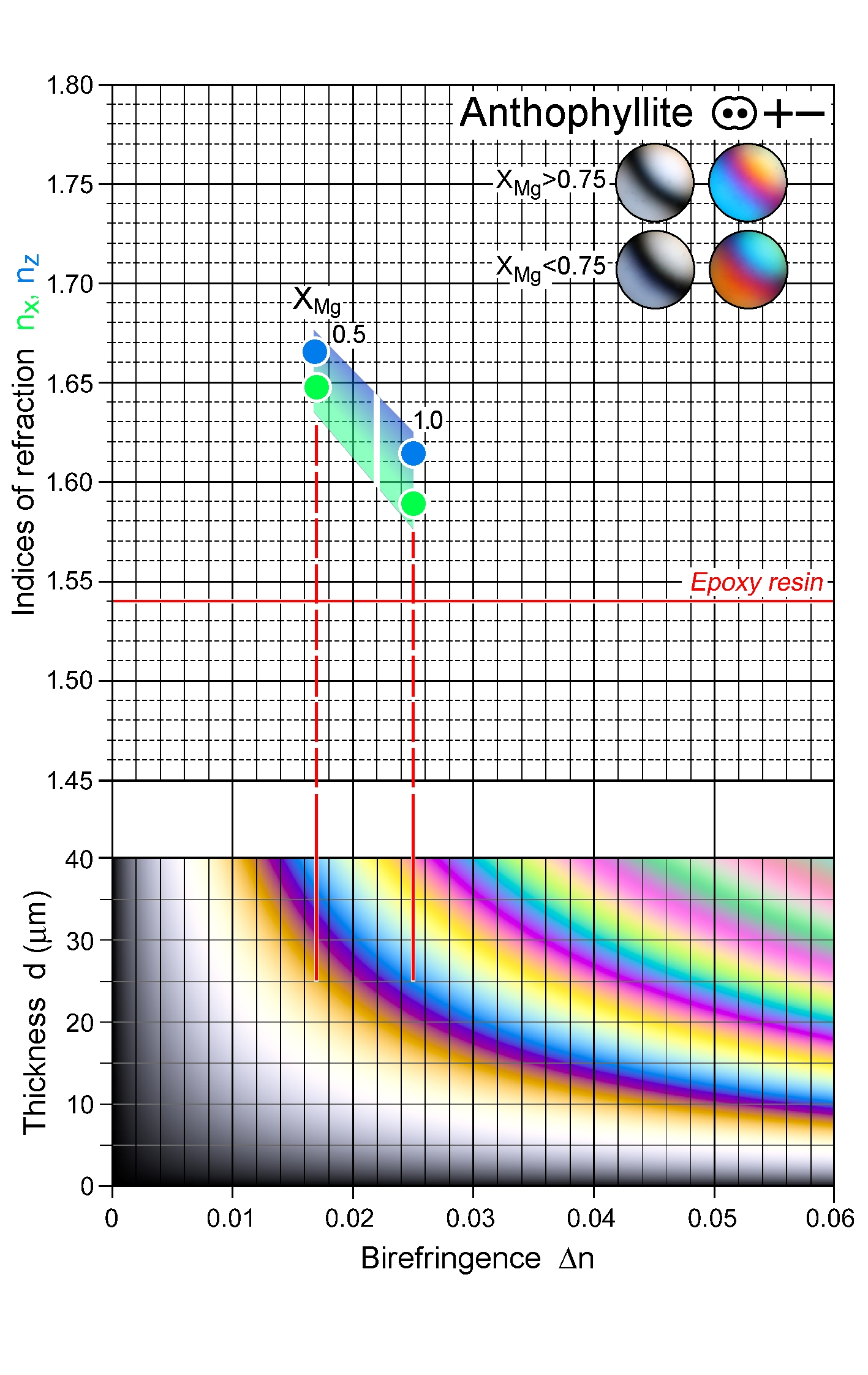|
| Formula | (Mg,Fe)7Si8O22(OH)2 |
| | Optic class & sign | Biaxial positive or negative |
| | Optical orientation | X = a, Y = b, Z = c |
| | Optical plane | (010) |
| | Relief | Moderate to high |
| | Refractive indices | nx = 1.587 -1.668
|
|
ny = 1.602 -1.670
|
|
nz = 1.613 -1.680
|
|
| n increases with increasing Fe as well as increasing Al (by Tschermak substitution) |
| | Birefringence (max.) | 0.013 - 0.026 |
| | | Δn decreases with increasing Fe |
| | Optic Angle
| 2Vx
= 65 - 90° |
| | 2Vz
= 90 - 55° |
| | Sign of elongation | Length-slow, l (+) |
| | Interference figure | Relatively high 2V; few isochromes. At about 80 mol% Mg-Ath changes from negative to positive optic sign (2V = 90°). |
| | Colour / pleochroism | Colourless to weakly coloured (brown) if Fe-rich
Weak pleochroism: Z > Y ≈ X or Z ≈ Y > X
|
| | Zoning | |
|
|
| Form | Habit | Long-prismatic; acicular, asbestiform; radiating aggregates; diamond-shaped {001} sections |
| | | Surface | Typically subhedral, with well-developed {110} prism faces |
| | Cleavage | 2 sets {110} perfect, at about 125 and 55° (seen in sections Ʇ c). In prismatic sections, the traces of the two principal cleavage sets are parallel. |
| | Twinning | None |
| | Extinction | Straight to prism faces and main cleavage in sections parallel c; symmetrical to {110} cleavage and prism faces in {001} sections. |
|
|
| Reaction textures | |
| | Alteration / decomposition | Talc, serpentine |
|
|
| Occurence | Ign | |
| | | Met | Ultramafic rocks, cordierite-orthoamphibole rocks representing magnesian metapelites or metamorphosed propylitic alteration zones associated with sulfide mineralization, amphibolites, and a diverse range of other medium-grade rocks. |
| | | Sed | |
| | | Hyd | Alkali- and Ca-depleted zones in metasomatic environments |
| | | Other | |
|
|
| Distinctive properties | Habit, Δn , characteristic amphibole cleavage, straight extinction (to distinguish from cummingtonite/grunerite), paragenesis |
| | Additional comments | The two Mg-Fe solid solution series, anthophyllite – ferro-anthophyllite and gedrite – ferro-gedrite, are connected by Tschermak substitution. At T above 600°C, there is complete miscibility between anthophyllite and gedrite.
Stripy patterns in {001} sections under +Pol indicate the presence (and possible intergrowth) of related multi-chain silicates such as chesterite or jimthompsonite (or their monoclinic varieties)
|
|
|

 Images
Images 


 Images
Images 
